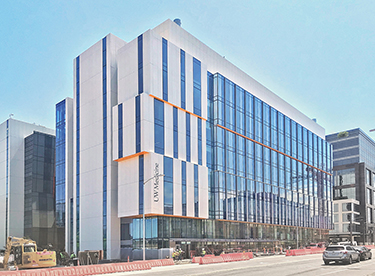|
Subscribe / Renew |
|
|
Contact Us |
|
| ► Subscribe to our Free Weekly Newsletter | |
| home | Welcome, sign in or click here to subscribe. | login |
Construction
| |
 |
November 21, 2019
Make your transition to a new building a smooth one
McKinstry

Cochrane
|

Kowalick
|
As buildings and systems become more and more complex, owners and operators are increasingly realizing that they can no longer easily pick up where construction leaves off.
Building-transition issues are a symptom for a much larger industry need and, as a result, buildings often do not operate as intended. So, how can we ensure that our buildings are meeting or exceeding performance expectations?
Enter the University of Washington School of Medicine (UWSOM), which in 2018 added the sixth building to its growing South Lake Union campus, bringing its total campus footprint to nearly 530,000 square feet. This sixth building is an eight-story, 165,000-square-foot facility. Like the rest of the campus, it supports a wide variety of uses: lab space, administrative offices and mixed-use space.
With such a diversity of uses, the building’s systems must also be complex — and efficient.
As with many sophisticated new facilities, ensuring that the building meets its functional design goals requires building operators to factor in its unique features and develop a procedural framework for monitoring and maintaining building systems. Since this building is a 24/7 critical environment, it required increased floor strength, higher ceilings for mechanical equipment and increased demands for electricity and water compared with an ordinary office building. The building also necessitated advanced vibration resistance since the lab space contains sensitive instruments.
UWSOM sought a partner who could meet its needs while allowing staff to focus on their core competency — research and medicine. Absorbing the new facility into regular operations presented challenges — including the development of a maintenance plan aligned with existing practices, migration of operations and maintenance processes into a work order management system, and the creation of an operating budget and long-term capital plan.
McKinstry helps customers like UWSOM create a foundation for successful facility operations by developing a unique facility transition process. The transition to sustainable operations (TSO) team at McKinstry leverages the company’s position as a national leader in designing, constructing, operating and maintaining high-performing buildings to deliver a re-engineered project close-out — focused on preparing the owner for successful, sustainable building operations.
Sustainable operations
TSO reduces downtime and operating expenses in the first year of occupancy and helps facility teams minimize risk and operating cost for the life of the building. By approaching project close-out from the operator’s perspective and aligning with the commissioning scope, TSO fills gaps in the turnover process and aligns construction output with operation team needs.
To ensure continuity of this knowledge and the operations that result from a smooth transition, McKinstry provides the systems and additional staff required to operate the facility during that critical first year.
The following scope was developed for this project:
• O&M manuals, commissioning/test and balance reports and submittals: Relevant construction documentation incorporated within work order management system.
• Expected life, replacement costs and warranty information: All asset data, along with estimated life, replacement costs and warranty information incorporated into the work order management system.
• Annual maintenance plan with budget: Frequency and hours-required information compiled for each building asset — organized in a planning tool to prioritize preventive maintenance and align with available resources.
• Equipment life-cycle planning: 30-year capital plan created for replacing aging equipment with inflation-adjusted annual capital budget forecasts. Plan delivered in a dynamic capital planning tool.
• System and energy performance optimization: Monitoring-based commissioning (aligned with design intent) delivered with monthly recommendations to maintain comfort, extend equipment life and reduce energy consumption.
McKinstry’s TSO services team helped the University of Washington transition the facility from construction to operations, with a focus on creating standards and procedures for how to best manage this critical facility. The team’s emphasis on taking a life-cycle analysis approach — studying the total cost of ownership over the life of the building — reduces the cost of operations over time.
First-year benefits
While TSO’s greatest impacts are realized over the life of the building, measurable benefits occur in the first year of operations. The result for University of Washington School of Medicine was a seamless transition from the construction phase to a highly stabilized, ongoing operations phase. Buildings often don’t operate the way in which their designers intended, and TSO is a solution to the problem.
With UWSOM, McKinstry:
• Identified more than $90,000 of operational energy savings improvements, including a faulty air-handler controller that overventilated the building by 25 percent above baseline.
• Identified more than $25,000 in warranty services and ensured there were no critical equipment failures or interruptions to regular operations in the first year.
• The team improved month-over-month operations by offering a half-dozen recommended changes to the system to ensure the facility operated as designed. This resulted in successfully maintaining comfort levels between 68 to 74 degrees during more than 95 percent of occupied hours.
• Migrated all relevant documentation into a work order management system, which allows maintenance technicians to review work history and troubleshooting guides for every piece of equipment in the facility.
• Developed a 30-year capital plan with expected equipment life and replacement costs.
• Created a corresponding preventive maintenance plan aligned with existing practices, ensuring operators can more efficiently resolve issues and maintain equipment to the satisfaction of the facility’s occupants.
The efficient preventive maintenance provided by McKinstry’s TSO team aligned with the existing University of Washington School of Medicine facilities team practices and eliminated the deferred maintenance backlog. What’s more, with more than 50 percent of the total cost of building ownership spent on operations, these benefits also grow over the life of the building.
All buildings, no matter how efficient or high-tech, require some time for operators and systems to adjust for actual building operations. Getting the first year of a building’s operations right is key to saving energy for the life of the building, and TSO is the key to getting that first year right.
Ric Cochrane is an account executive and Mike Kowalick is a senior program manager, both at McKinstry.
Other Stories:
- Designing classrooms that meet the needs of tomorrow’s jobs
- 3 projects that show how unique context can inspire unique design
- 3 STEM projects that aim to break down learning silos
- How higher ed projects can benefit from P3 delivery
- Why it’s a good idea to use mechanical design-build for your school project
- New lab building anchors UC San Diego research park
- How maker labs can open doors to STEM careers
- UW building takes fast track with integrated design-build
- Community college complex will be a hub for agriculture
- Creating a sense of place for students in rural Washington



